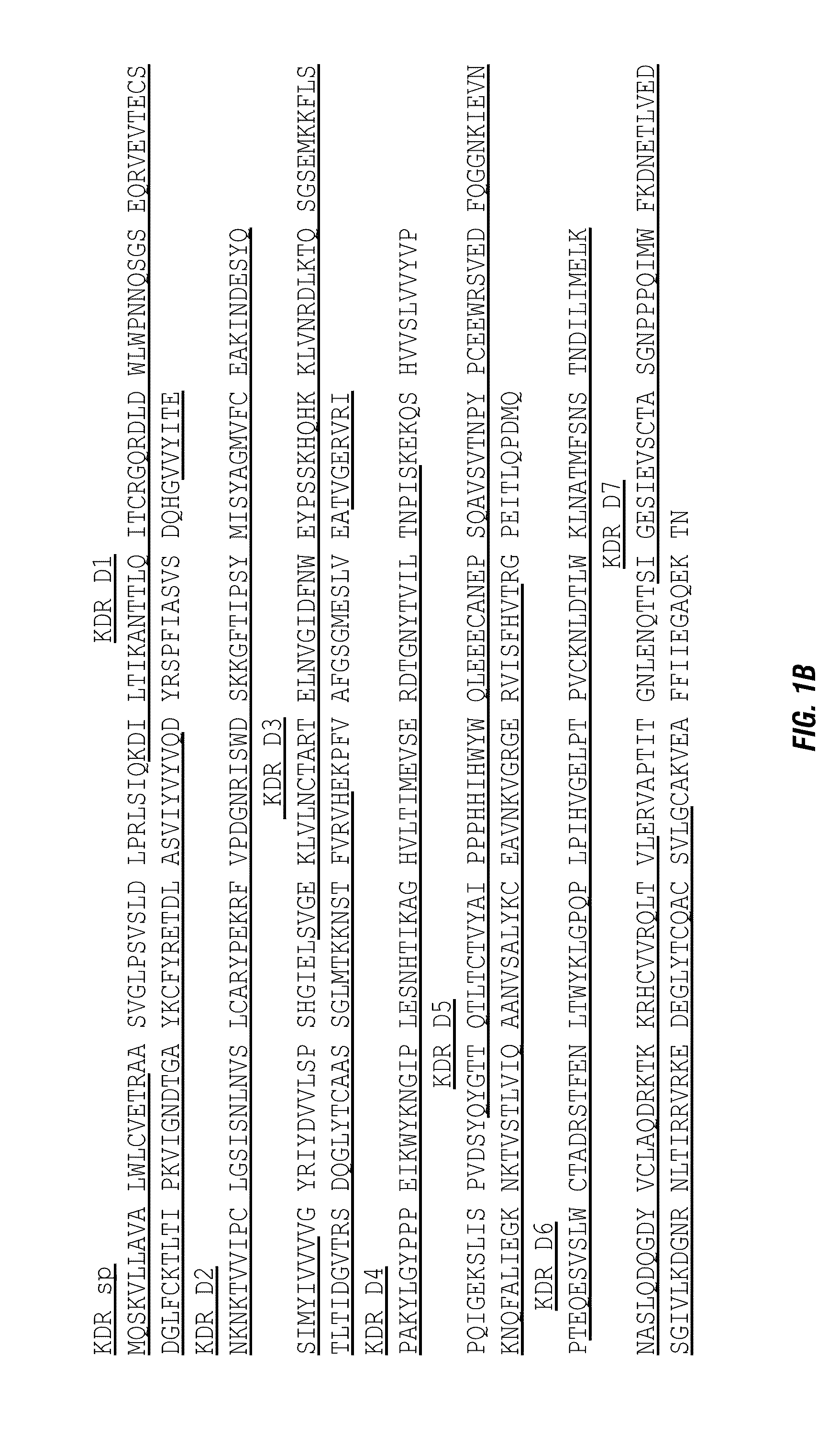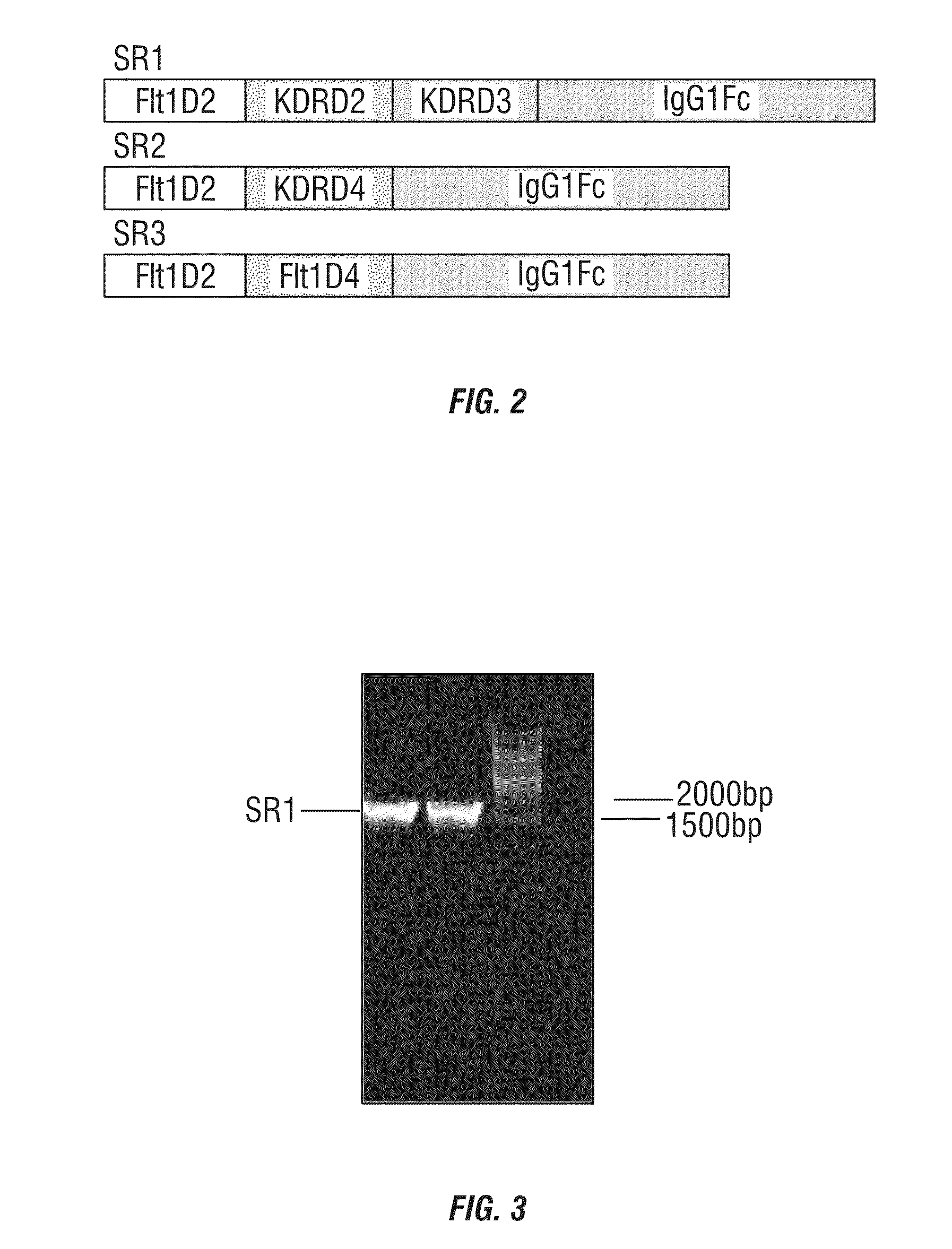Anti-angiogenesis fusion proteins
a technology of fusion proteins and anti-angiogenesis, which is applied in the field of gene engineering, can solve the problems of low binding affinity, inability to inhibit the effect of placental growth factor, and the inability to further develop fusion proteins
- Summary
- Abstract
- Description
- Claims
- Application Information
AI Technical Summary
Benefits of technology
Problems solved by technology
Method used
Image
Examples
example 1
Construction of Fusion Proteins and Expression Vectors
[0095]The amino acid sequences of candidate proteins were obtained from the GenBank for Flt1 (NP—002010.2) and KDR (NP—002244). These candidate protein domains were fused to the amino acid sequence of human IgG1 Fc (P01857, 104-330). Signal peptide comes from Flt1 (NP—002010:1-26). FIG. 2 exhibits the schematic structures of fusion proteins SR1-3.
[0096]Recombinant DNA sequences were obtained by molecular cloning techniques, and inserted into the expression vector pcDNA3.1 after XbaI / HindIII restriction enzyme sites were added. The constructed recombinant DNA is run on an agarose gel and the result is shown in FIG. 3.
example 2
Expression and Purification of Fusion Proteins
[0097]After transient transfection of the expression vector into a cell line, the fusion proteins were expressed and purified. Once the fusion protein proved effective in animal models, the suitable expression vector was transferred into a CHO cell line. Highly expressing clones were selected and expression and purification of the fusion proteins from stable CHO cells were performed. The stable cell line with a relative high titer was used for manufacturing.
[0098]Transient Cell Expression
[0099]Well-grown exponential stage Freestyle 293F cells were seeded at a density of 1×106 / ml. The following day, Vector DNA was mixed with Freestyle MAX Reagent at 1:1.2 ratio and kept at room temperature for 10-15 minutes, then added to the media slowly. Cells were incubated at 37° C., 8% CO2 concentration, and shaken at 135 rpm for three days. The culture medium was harvested and fusion protein purified with a Protein A affinity column.
[0100]Purified f...
example 3
In Vitro Binding Assay of Fusion Proteins
[0106]Binding Ability of Fusion Proteins with VEGF
[0107]Binding assay of fusion proteins with VEGF were performed by quantitative ELISA kit using VEGF-Trap as control. Fusion proteins were mixed in serial concentrations with 40 pM human VEGF165, and incubated at 37° C. for 1 hour. After washing, goat anti human IgG Fc-HRP was added and TMB visualization was performed. The EC50 for the fusion protein SR1 and VEGF-Trap was calculated.
[0108]Results from the in vitro binding assay are shown in FIG. 7. From the initial results, the fusion protein SR1 has a higher binding affinity to VEGF with an EC50 of 0.092 μg / ml, in comparison, VEGF-Trap has an EC50 of 0.136 μg / ml.
[0109]Binding Stoichiometry of SR1 with VEGF Using BIACcore™
[0110]SR1 was captured with an anti-Fc specific antibody that is first immobilized on a BIACcore™ chip using amine-coupling chemistry. A blank antibody surface was used as a negative control. VEGF165 was injected at a concent...
PUM
| Property | Measurement | Unit |
|---|---|---|
| humidity | aaaaa | aaaaa |
| concentration | aaaaa | aaaaa |
| concentration | aaaaa | aaaaa |
Abstract
Description
Claims
Application Information
 Login to View More
Login to View More - R&D
- Intellectual Property
- Life Sciences
- Materials
- Tech Scout
- Unparalleled Data Quality
- Higher Quality Content
- 60% Fewer Hallucinations
Browse by: Latest US Patents, China's latest patents, Technical Efficacy Thesaurus, Application Domain, Technology Topic, Popular Technical Reports.
© 2025 PatSnap. All rights reserved.Legal|Privacy policy|Modern Slavery Act Transparency Statement|Sitemap|About US| Contact US: help@patsnap.com



